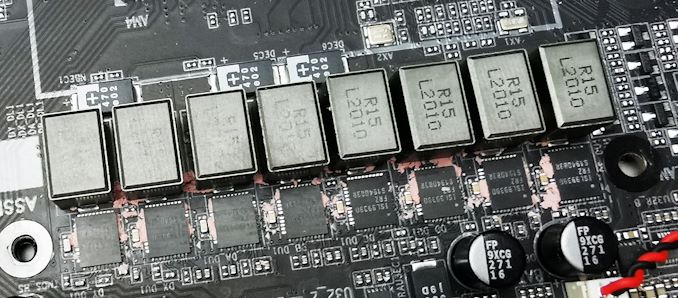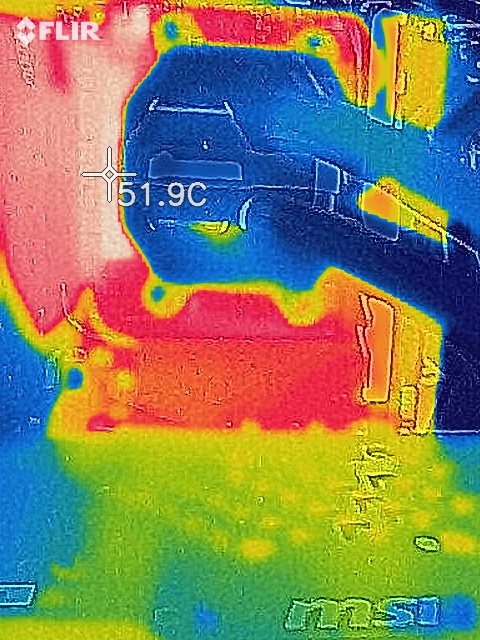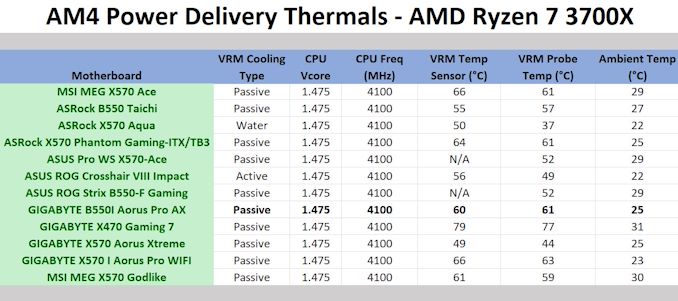The GIGABYTE B550I Aorus Pro AX Motherboard Review: All The Small Things
by Gavin Bonshor on December 7, 2020 10:00 AM ESTPower Delivery Thermal Analysis
One of the most requested elements of our motherboard reviews revolves around the power delivery and its componentry. Aside from the quality of the components and its capability for overclocking to push out higher clock speeds which in turn improves performance, is the thermal capability of the cooling solutions implemented by manufacturers. While almost always fine for users running processors at default settings, the cooling capability of the VRMs isn't something that users should worry too much about, but for those looking to squeeze out extra performance from the CPU via overclocking, this puts extra pressure on the power delivery and in turn, generates extra heat. This is why more premium models often include heatsinks on its models with better cooling designs, heftier chunks of metal, and in some cases, even with water blocks.

The 8-phase power delivery operating at 6+2 on the GIGABYTE B550I Aorus Pro AX
Testing Methodology
Out method of testing out if the power delivery and its heatsink are effective at dissipating heat, is by running an intensely heavy CPU workload for a prolonged method of time. We apply an overclock which is deemed safe and at the maximum that the silicon on our AMD Ryzen 7 3700X processor allows. We then run the Prime95 with AVX2 enabled under a torture test for an hour at the maximum stable overclock we can which puts insane pressure on the processor. We collect our data via three different methods which include the following:
- Taking a thermal image from a birds-eye view after an hour with a Flir Pro thermal imaging camera
- Securing two probes on to the rear of the PCB, right underneath CPU VCore section of the power delivery for better parity in case the first probe reports a faulty reading
- Taking a reading of the VRM temperature from the sensor reading within the HWInfo monitoring application
The reason for using three different methods is that some sensors can read inaccurate temperatures, which can give very erratic results for users looking to gauge whether an overclock is too much pressure for the power delivery handle. With using a probe on the rear, it can also show the efficiency of the power stages and heatsinks as a wide margin between the probe and sensor temperature can show that the heatsink is dissipating heat and that the design is working, or that the internal sensor is massively wrong. To ensure our probe was accurate before testing, I binned 10 and selected the most accurate (within 1c of the actual temperature) for better parity in our testing.
For thermal image, we use a Flir One camera as it gives a good indication of where the heat is generated around the socket area, as some designs use different configurations and an evenly spread power delivery with good components will usually generate less heat. Manufacturers who use inefficient heatsinks and cheap out on power delivery components should run hotter than those who have invested. Of course, a $700 flagship motherboard is likely to outperform a cheaper $100 model under the same testing conditions, but it is still worth testing to see which vendors are doing things correctly.
Thermal Analysis Results

We measured 51.9°C on the hottest part of CPU socket area during our testing
The GIGABYTE B550I Aorus Pro AX is using an 8-phase design that operates in a 6+2 configuration. It consists of six Intersil ISL99390 90 A power stages for the CPU VCore, and two ISL99390 90 A power stages for the SoC. (insert doubler). Cooling the power delivery is a large single heatsink that molds into the design of the board's plastic rear panel cover and is connected to the M.2 and chipset heatsink. It relies primarily on brute mass and good passive airflow within a chassis.
Looking at the GIGABYTE B550I Aorus Pro AX's power delivery thermal results in comparison to other AM4 models we've tested with our Ryzen 7 3700X processor, it performs pretty well all things considered. We typically see higher temperatures on mini-ITX motherboards which is a direct result of cramped componentry on a small PCB. Where an ATX size model can utilize PCB space to split power deliveries into two elements with one to two heatsinks to dissipate the heat more effectively, the GIGABYTE power delivery operates in a single strip with a single heatsink doing all of the heat removal.
We observed a reading of 61°C from our first K-type probe on the rear, with our second consistent with a slight variance of 59°C. This is also consistent with the reading from the board's VRM temperature sensor of 61°C, which shows the heatsink is efficiently removing heat as our thermal imaging camera shows the hottest part around the socket reached just shy of 52°C. This is good for a mini-ITX model and it shows GIGABYTE has another highly efficient power delivery design on its hands.











76 Comments
View All Comments
quorm - Monday, December 7, 2020 - link
What is the massive AMD AM4 keep out area?Slash3 - Monday, December 7, 2020 - link
The space around the CPU socket required for mounting clearance is probably what they're referring to. On that note, the Asrock AM4 mITX actually use Intel LGA11XX mount spacing for this reason.meacupla - Tuesday, December 8, 2020 - link
The AM4 keepout area is a good thing though. Especially when the mobo adheres with the steel backplate.There are plenty of LGA11XX mITX boards that completely ignore the back side of the MOBO and run into issues with aftermarket CPU coolers that require backplates.
Allan_Hundeboll - Thursday, December 17, 2020 - link
I "upgraded" from ab350 fata1ity to the b550i Aorus pro because I wanted a board that would support ryzen 5000. I also hoped the better vrm would make it possible to oc my water-cooled 3700x a little higher.But the the b550I seems to hate my 2x16GB micron rev E memory. So I just can't make 1900Mhz IF/3800Mhz MEM stable like it did on the cheap ab350.
The strong VRM didn't oc my 3700x any better, but I discovered that low PBO power draw values (like 5W) makes. PBO boost like crazy, when disabling C3 sleep. So my cpu benchmarks gained a little performance.
So you made a smart decision holding on to that ab350!
Mr Perfect - Monday, December 7, 2020 - link
The lack of USB ports is odd, especially when they included three video ports that a majority of people will never use. If AMD CPUs had built in video ports, then sure, throw in a whole bunch of graphics ports, but a gaming board isn't likely to get an APU installed.calc76 - Monday, December 7, 2020 - link
The B550 chipset is the limiting factor with USB 3 ports. The B550 isn't really in the same class chipset as a Z490. The B550 supports more ports than are in some of the mini-ITX boards but ones like the ASUS B550-I support nearly all but some of the extra USB 2.0 ports.mkarwin - Tuesday, December 15, 2020 - link
Even with USB3 count restriction, there are still USB2 options - most printers/keyboards/mice/scanners won't need the gen 3 speeds so adding a quartet of additional rear I/O placed USB2 ports wouldn't break the bank whilst giving a lot more connectivity that people could actually use... Though at the same time, X570 boards from the same product family are not fairing any better whilst being "top of the line AM4 chipsets" sporting. Somehow the ATX size allows adding more ports to the rear I/O, but already mATX suffers nearly the same as mITX. I'm not sure if those ATX offerings come with additional USB controllers on board that just can't fit on ITX boards or maybe it's merely manufacturers way to skimp $1 on a set of connectors on the back and treat it as an excude for no additonal signaling work through the PCB whilst still asking higher prices for the premium smaller market...Luminar - Monday, December 7, 2020 - link
Just what we need instead of a 6800 review lolGolgatha777 - Monday, December 7, 2020 - link
True, you can actually buy this.vanilla_gorilla - Monday, December 7, 2020 - link
This is exactly what I need. I'm currently using an X570 I Aorus Wi-Fi mini-itx board in a SFF case. The problem is I cannot find any AM4 Mini-iTX boards with multi-gig or 10GbE LoM. I'm really disappointed we don't see more multi and 10Gb boards. I just got an email last week that Google Fiber now offers 2Gb/s service here in Nashville. I was looking at USB based multi-gig adapters but I'd much rather have it on the motherboard, of course.